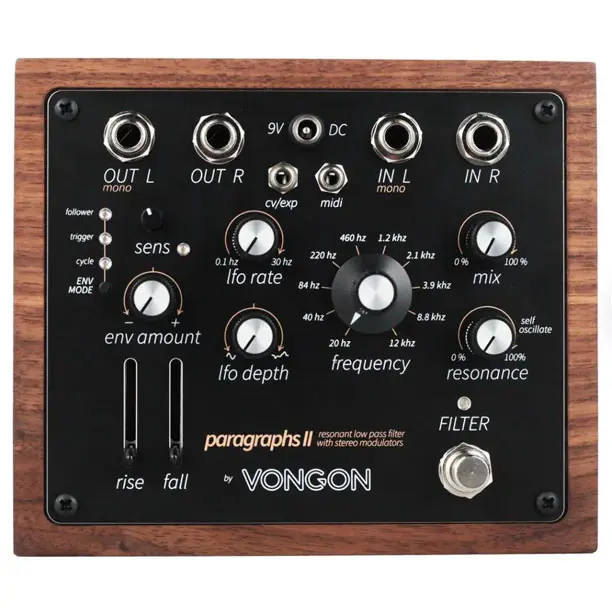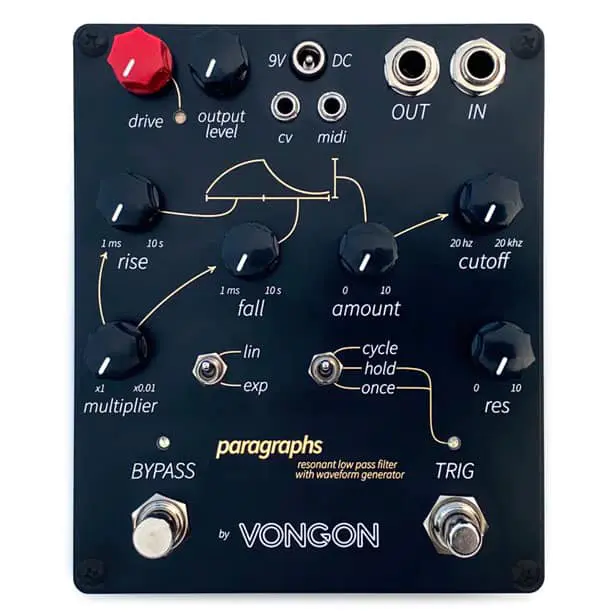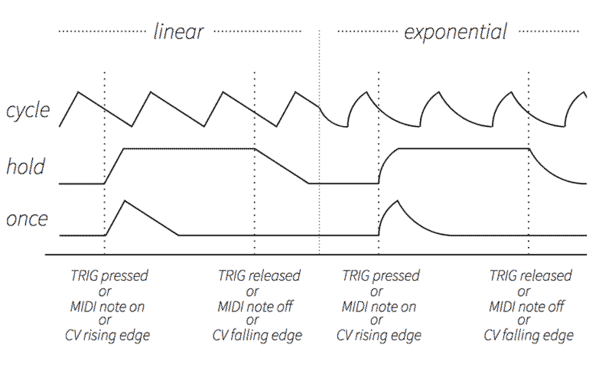
Vongon is a rather new pedal (and now also synth) brand based in Oakland that manufactures very intriguing and creative stompboxes. The Paragraph II is the updated 2024 version of their very first product: an analog four-pole resonant low-pass filter with stereo modulation (the previous version was mono).
A comparison of the two versions shows a rather radical redesign of the circuit, with the added bonus of the signature wooden frame around the case in MkII.
The heart of the circuit is a proprietary digital filter developed by the company for their Replay synthesizer which replaces the analog AS3320 analog chip found in the first version but offers the same warm tone of its predecessor, minus the analog unpredictability. It can be edited via attack, decay, and envelope generator.
This device’s most intriguing feature is the LFO section which can create a wide range of “auto-wah” fluctuations thanks to a unique set of controls that have expanded in MkII to respond to your playing.
In Follower mode, the filter adjusts based on your signal’s volume, while Trigger mode uses transients to trigger the envelope when signals pass a threshold. For rhythmic or synth-like effects, Cycle mode turns the envelope into an LFO. You can shape the sound with rise and fall times from 5 milliseconds to 4 seconds, allowing for quick jolts or slow swells.
An additional LFO modulates the left and right channels, opening up the stereo field. As the depth increases, the modulation becomes more random, producing effects like tremolos, tape machine warbles, and even ring-mod-style tones.
This is also a pedal made to work seamlessly with synths, thanks to its CV and Midi inputs.
The Paragraphs II looks like a fun new entry for the creative-oriented guitarist and synthesist.
[Wanna get this baby and be supportive? Buy it through our Perfect Circuit affiliate program – at no extra cost.]
Vongon Paragraphs V1

The original version of the Paragraph was based on an AS3320 analog chip, a modern replica of the same component used in analog classics like the Sequential Prophet 5.
It had an extra “Trig” footswitch, which – rather uniquely and very handily – starts an LFO cycle in different ways depending on the mode selected. This graph should clarify its function:

It also featured flexible gain stages, with a Gain knob that can both boost the lower-level signals and drive any instrument to a clipping fuzz.
Paragraphs is an analog four-pole resonant low pass filter with an attack, decay (AD) envelope generator designed with focus on simplicity and flexibility.
Low Pass Filter
The heart of the filter circuit is the AS3320 analog chip — a modern replica of the same component used in analog classics like the Sequential Prophet 5, Pro-One mono-synth, Elka Synthex, and the LinnDrum. Cutoff spans the full audio spectrum and resonance starts to self-oscillate at about seventy percent.
Modulation
The envelope generator offers modulations in an uncommonly wide range of frequencies — starting as low as 0.05 hz for slowly evolving 20 second long cycles, and reaching up to (and past) the audio threshold at 300 hz for a wave shaping effect similar to sounds found on west coast style synthesizers (“think Buchla”).
Flexible Gain Stages
Paragraphs accepts instrument and line level signals. Dedicated controls for input (drive) and output level make it easy to move between a crystal clear clean tone and and a clipping fuzz. A multi-color LED provides a visual representation of the signal level. Red indicates clipping. Orange flashes indicate the start of overload. Green indicates the presence of signal at or below the nominal level.
CV and MIDI
Inputs for Control Voltage (CV) and midi are available to remotely trigger the envelope generator. This enables your Paragraphs to stay in rhythmic synchronization with external systems like midi sequencers, euroracks, and digital audio workstations.
Specifications
- 1/4” mono input/output jacks
- 2.1mm DC Connector
- 5.7” x 4.7” x 1.5” enclosure dimensions
- true bypass
- input impedance: 1M?
- output impedance: <1k?
- power supply: 9 to 9.6 VDC center negative
- current draw: 100mA max






















